One with Nature at Kodikkarai
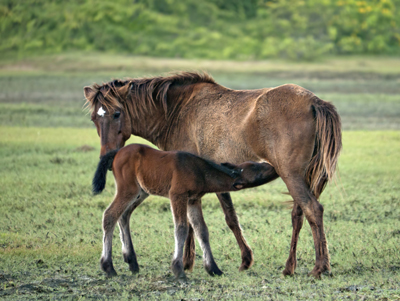 Female feral mare and offspring |
Kodikkarai, also called Point Calimere, is a low-lying headland in Nagapattinam District and is where the 25 sq.km Point Calimere Wildlife and Bird Sanctury is. The Sanctuary was created in June 1967 to help conserve the blackbuck which is endemic to India and dwindling in numbers. The sanctuary habitat is a mix of grasslands, mudflats, backwaters, saltpans, sand dunes and tropical dry evergreen forests. Mangrove forests are also found near Muthupet. The long Pongal weekend was when we visited.
January 13th: We reached the Blackbuck Forest Guesthouse at 6.45 a.m. or so. After a long wait we got our keys and finally unlocked the door to our room. We were dissatisfied with it at once, so it was only after we found a better room on the first floor – with a bathroom that actually had a toilet with a toilet seat on though broken, but there it was nonetheless, and a flush that actually worked – that we dumped our backpacks, unpacked and settled down.
The first place we went to after breakfast was the mudflats (or were they saltpans?). We walked among the very large and small pools of saltwater that had been brought in from the sea. The large pools of water were separated by man-made mounds of dry soil. Though proximity to water resulted in wetter soil, the land still looked parched. But looks can be deceiving. While in most places, especially the mounds, it was perfectly safe to walk around, some areas were very marshy and when the earth gave way under your feet, it certainly was not a pleasant sensation.
There were many water-birds in the area including gulls, terns, herons and egrets. We then moved on to the pump house. On the way there we saw brahminy starlings, their black crowns and red breasts glistening in the sun. There were also some bee-eaters and someone saw a black-naped hare.
We arrived at pumping time so we got to see some spectacular sights. Birds were flying in every direction in some kind of feeding frenzy near the pump house, where water was being pumped out, causing the body of water to churn and spit out fish which, obviously, the birds were targeting. Most of the birds were gulls but there were also four brahminy kites swooping in from nearly everywhere.
Around 3 o’clock we drove to the Sanctuary. Our vans sped past feral horses, blackbuck, spotted deer, plovers and terns, halting from time to time to allow us to click pictures of a whole herd of horses, of blackbuck running, of some waterbirds and waders by one of the small water bodies, and of a kestrel perched on a cluster of branches.
The Sanctuary’s vegetation is like scrubland meeting grassland with few trees. The vegetation becomes a bit thick near the beach, forming a sort of barrier.
Finally the British lighthouse came into a clear view. The lighthouse, built in 1890, is not a very tall building. Around it is a wall which has signs like ‘Visitors not allowed’ fitted near the gate. Some distance from the lighthouse is the beach, which was our final destination before returning to the guesthouse.
The beach was very different from the Chennai beach. Firstly, the beach was dotted with a variety of shells, including several kinds that are hard to find on the beaches of Chennai. Secondly, there were not many waves crashing onto the beach. Further out at sea, you could see the breakers dashing against an invisible barrier: there was definitely a barrier of sand submerged in the sea somewhere there that was breaking the force of the water. Thirdly, there was some kind of sad-looking, worn-down brick structure jutting out of the water in the calm regions behind the sand barrier. It was covered in barnacles around the base, where it was in constant contact with the sea. It also had a thick layer of bright green moss, so thick and bright that from a distance it looked as though there was grass growing over the structure. Overall it was an unimpressive sight. Having said that, imagine my shock when I learnt that it was the great Chola lighthouse! I had imagined a better preserved structure, but later found out that the lighthouse was wrecked in the 2004 tsunami. No amount of maintenance is likely to be able to fix the damage. We waded upto the structure. Beneath the water, the structure extended sideways a bit more than expected.
At the beach, there was a watchtower from which you got an amazing view of the setting sun.
January 14th: At 5 a.m. we set out for the mangrove forests. An hour and a half later, we reached the bank of a small river where five boats were docked. The journey along the river took a long time. We saw many kingfishers, cormorants, brahminy kites (these were so common, it was starting to get annoying) and gulls flying in the sky and diving and swimming in the water. Everywhere cormorants landed on the water and, after paddling a bit, they dived in and soon reappeared quite some distance away. Everywhere in the trees there seemed to be a nest. Everywhere there were pied kingfishers sitting on a branch, hovering in the air and then plunging from a great height into the water. Everywhere gulls flapped and flew about. Everywhere there were birds.
We eventually reached the boardwalk that goes through the mangrove forests. The boardwalk was in dismal condition. Most of the planks were broken and were lying around among the roots. Somebody had taken the trouble to build this elevated boardwalk but nobody seemed to care about maintaining it. It was quite disheartening. But we couldn’t stop now. There was only one thing left for it and that was to walk in the mud. Few dared to do so. After they returned, we boarded the boats once more.
After a break at Muthupet, we left for a birding spot some 6-7 km away, the Udayamarthandapuram Bird Sanctuary. An irrigation tank fed by water from the Mettur Dam, the Sanctuary is a bird and butterfly lovers’ paradise providing a quiet and nice environment except for the noise made by the birds. The water body is surrounded by vegetation and a path that goes all the way around, a distance about 3 km. The place was full of pond herons, grey herons, night herons, purple moorhens, and we also saw pheasant-tailed jacanas, black-headed munias, white ibises and darters. There was also an osprey perched on a pole in the middle of the water body. An eagle was also seen, though there was some debate on its species.
The butterflies seen included striped tiger, crimson rose, common jezebel, peacock pansy, lemon pansy and common wanderer.
Just before 5 p.m., we went to the main lighthouse, a fairly tall building painted in red and white stripes. This lighthouse has a flash pattern of one flash every ten seconds. Unfortunately, we weren’t allowed inside, though the man in the guesthouse had said visitors were allowed till five in the evening.
Later in the evening a few of us did a night walk. We walked along the road from about 10 p.m., flashing our torches everywhere looking for roosting birds and snakes. Unfortunately for us, it seemed like all the animals had been wiped off Point Calimere because there was absolutely nothing. We had no choice but to turn back – but the best part on the way back was when the power suddenly went out and we had to travel back guided only by the light from our torches…and the stars. Even in small places like Kodikkarai where the sky is always so clear, it’s only when the lights go out completely that you realise how magnificent the sky is and how insignificant and small we are.
January 15th: We walked further from the pumphouse, onto the bunds and into the wide-open salt-pans, and onto the soft and squelchy mudflats. Besides large numbers of terns, flocks of plovers were seen at the water’s edge and large groups of painted storks and pelicans were standing undisturbed in the distance.
Walking barefoot wasn’t so bad except there were shells everywhere embedded in the mud and they were very sharp. You see the sea had come into the saltpans/mudflats and left behind millions of shells firmly embedded in the earth.
Later we decided to check out the museum which was open 24x7 (behind the guesthouse were a group of buildings including a small interpretation centre and museum). It consisted of three rooms, one explaining the medicinal plants found in the tropical dry evergreen forests, another with shelves containing the various kinds of shells found in the area, and the third room with preserved birds (and an entire wall covered with pictures of some of the numerous birds that could be found in the Sanctuary). The museum was interesting, but it was poorly maintained. The entire place was caked with dust and it was clear the place hadn’t been cleaned in months.
January 16th: We left for home, leaving behind us Point Calimere and its mudflats, saltpans, grasslands, forests, lighthouses and beaches, but filled with memories.
– Uttara
Rare sightings
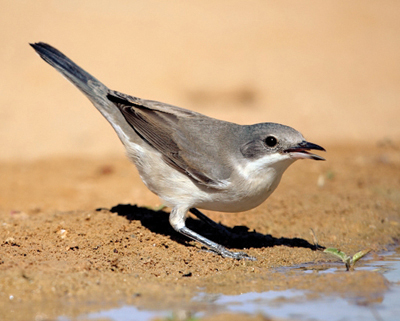
Orphean
Warbler |

Tawny-bellied Babbler |
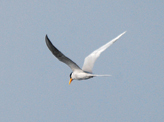
River Tern |
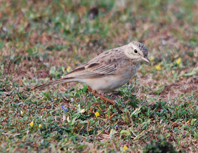
Tawny Pipit |
This Orphean Warbler was seen near Vedan-thangal by the team Emerald Dove (Kumaran Sathasivam, Ramila Sathasivam, Sushmitha and Sajani) during the Chennai Bird Race 2012.
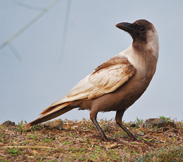
Albino Crow |
K. Gnanaskandan, while scouting around his favourite haunt, Siruthavoor, spotted a White Crow (Albino), River Tern and a Tawny Pipit. Murugan Mohan was chasing a Robin couple at Siruthavoor, when he noticed a dozen birds diving from one bush to another… typical of babblers but, since they were much smaller, he didn’t realise they were Tawny-Bellied Babblers. These record shots were all that he saw of them.
Snakes and trees of South India
During my recent visit to Madras, I was given two natural history books written by Madras authors. I am convinced that these two books will be of interest, relevance, and use to readers of Madras Musings. The first is the Illustrated Book of South Indian Snakes by B. Vijayaraghavan and S. R. Ganesh, published by the Chennai Snake Park Trust (2011). The second is the Trees and Tree Tales by K.N. Rao, published by Oxygen Books (New Horizon Media, Madras)* in 2007.
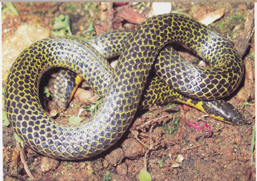
1. Periyar Shieldtail (Uropeltis arcticeps madurensis): Non-venomous, 6 inches. Southern Western Ghats. Found under fallen logs and rocks. Black, purplish brown. Rare.
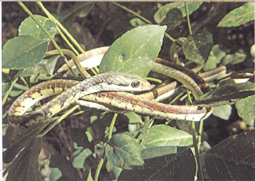
2.Common bronze back(Dendrelaphis tristis): Non-venomous, 3 ft. Throughout most of peninsular India. Seen on trees and shrubs. Dark grey with yellow stripe. Common.
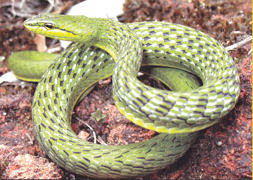
3.Bronze-headed vine snake (Ahaetulla perroteti): Mildly venomous. 1.5 ft. Southern Western Ghats. Seen in open, high-altitude grasslands. Bright green; sometimes olive brown. Common.
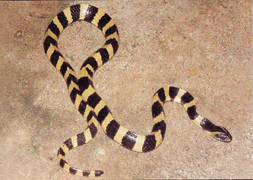
4.Banded krait (Bungarus fasciatus): Venomous. 5 ft. Eastern India. Found in farms and gardens near water. Feeds mainly on snakes. Black with broad yellow bands. Common.
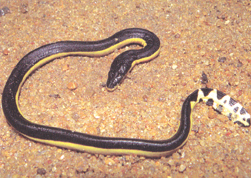
5.Black and yellow sea snake (Pelamis platura): Venomous. 2 ft. Throughout most of Indian coast. Black above, yellow below, Uncommon. |
Vijayaraghavan’s passon towards reptiles in general and snakes in particular is well known. He has published several books on these amazing animals and the 2011 book is not only an elegant but also a worthwhile addition to the list of his publications and to knowledge of snakes of southern India. This slim, compact book – truly a handbook – includes 15 chapters that deal with diverse aspects of southern Indian snakes. Meant for a popular readership, the book does ample justice by providing brief information on the snakes and other reptiles of India in chapters 2 and 3. Madras being a coastal town, many residents nowadays are excitedly taking to sea-swimming more than before; in that context, chapter 5 on sea snakes is significant.
The key chapter of the book is chapter 13 which provides illustrated descriptions of different kinds of snakes. The chapter provides succinct information on worm snakes (or blind snakes), shieldtail snakes, pythons, sand boas, wart snakes, ‘typical’ snakes, cobras and their allies, sea snakes, and vipers. Vijayaraghavan and Ganesh surprised me, pleasantly it must be said, with a stunning list of 124 different kinds of snakes in this chapter. Excellent colour-rich photographs of adults of 71 kinds of snakes add value to the chapter.
Chapter 12 focusses on those who contributed to Indian-snake studies (Herpetology). Brief notes refer to contributions of 28 amateur and professional snake biologists, starting with Patrick Russell, the Scottish medical doctor who pioneered Herpetology in the 18th Century Coromandel. Seeing the photos as well as reading the brief biographies of Madras snake biologists M.V. Rajendran, T.S.N. Murthy, and Romulus Whitaker was gratifying. Nonetheless, I must confess that I was disappointed in not seeing any reference to the late Charles Leigh sj (a Jesuit who taught English in Loyola College, Madras, in the 1930-1940s). He had avidly studied the biology of the southern Indian pythons. Leigh, in spite of being an academic who taught English language and literature, published occasionally on the biology and behaviour of the Indian rock python (Python molurus molurus) in professional journals, such as the Journal of the Bombay Natural History Society, and frequently in popular newspapers such as The Madras Mail. A few examples of Leigh’s professional publications are: ‘Notes on the Indian python’, Journal of the Bombay Natural History Society 33 (1928); ‘Breeding of python’, Field 1556 (1936); and ‘Age and growth of python’, Field 404 (1936). I also wished that Vijayaraghavan and Ganesh had included the following two classics in Indian Herpetology in the list of books on Indian snakes: Albert C.L.G. Gunther’s The reptiles of British India (1864), the first systematically organised volume that refers to snakes and other reptiles of India, and Edward Nicholson’s Indian Snakes: an elementary treatise on Indian Ophiology with a descriptive catalogue of the snakes found in India and the adjoining countries (1874), the earliest authentic and exclusive volume on Indian snakes.
Chapter 6 explodes Indian myths on snakes and describes established facts. Chapters 9 (on snakebite), 10 (on first aid and treatment), and 11 (on the good that snakes do) offer useful information to readers. Tidbits on snakes across the world supplied as boxed items add value to the information provided. I was impressed by Vijayaraghavan’s brilliant introductory note referring to vanishing modesty and intensifying arrogance of XXI Century humans. This note needs to be reflected upon by every human being.
* * *
K.N. Rao, author of the tree book, is an octogenarian resident of Madras, who retired as the Professor of Botany after long teaching stints at Pachaiyappa’s and D.G. Vaishnava Colleges, Madras. Besides being a much sought-after teacher of Botany, he is an erudite scholar in English, Telugu, and Sanskrit. It is indeed a pleasure to note that Rao decided to share his botanical knowledge with residents of Madras by talking to us on the trees of Madras.
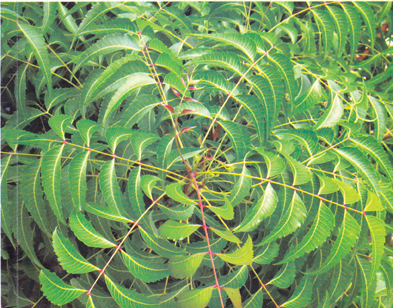
6.Neem leaf
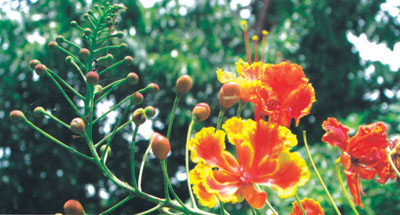
7.Gulmohur
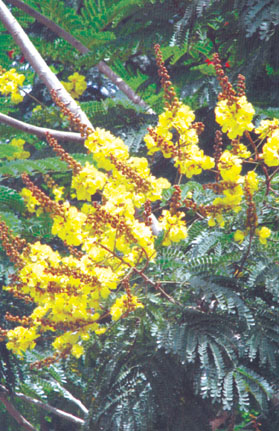
8.Copper pod tree

9.Rain tree
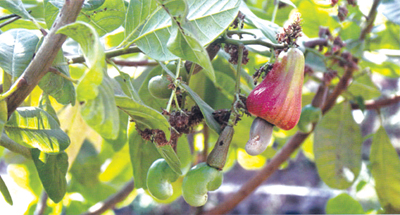
10.Cashew Nut |
Compared with the snake book, the tree book consists of slightly larger pages, but is equally slim. Eleven chapters comprise the book. Two exclusive chapters refer to two botanical delights of Madras: the coconut (plus a few other palms) and the neem. Other chapters refer to those that produce legumes (specific fruit types such as beans), the trees that are considered sacred, trees that bear brilliant flowers and those that do not (but charm people as leafy ornamentals), fruit-bearing trees, the less commonly occurring trees, and the rare ones, and a few others that do not fit into any of these categories.
Having known Rao for more than two decades and having worked with him closely, I was not surprised that he had cleverly linked cultural practices that are associated with the trees listed and described. For example, he refers to the punnai’s (Calophyllum inophyllum) association with Krishna worship. Such snippets are plentiful in the book. As I read through the book, I was amazed at Rao’s effort to provide details of enchanting connections of Madras trees with various aspects of Indian culture. I have always argued that names of plants have strong connotations with what we have known before. For example, Rhizophora mucronata (a tree commonly occurring in Killai estuaries near Chidambaram) is known as surapunnai in Tamil. The interesting similarity between punnai and surapunnai is that they bear apparently similar leaves; however, the difference is that the surapunnai secretes milky latex and and hence our ancestors named Rhizophora mucronata as surapunnai, after punnai that secretes latex ([pal]) surakkum punnai). A similar trend is inferable between arasu (Ficus religiosa) and pu-arasu (Thespesia populnea).
There are 47 excellent colour photos in this book, which bring out in close-up details different kinds of trees referred to. The book cover includes a delightful view of the leaf cluster of neem – an enchanting Indian tree, which has wonderful medicinal properties and is highly valued in Indian traditions.
Vijayaraghavan and Ganesh have provided useful and relevant information on the snakes of southern India; K.N. Rao takes us through the variety of useful and colourful trees of Madras. The authors of both books have provided technically accurate information in simple and lucid prose, targeting readers who would be unfamiliar with biological vocabulary. For the quality of information supplied and photographs included, the prices of both books (Rs. 650 – the snake book; Rs. 200 – the tree book) are certainly affordable, considering the price a person needs to pay for a ticket in cinema houses in Mount Road these days!
– Dr. A. Raman
(1 - 5) All photographs by S.R. Ganesh. Copies of book available at The Chennai Snake Park Trust.
(6 - 10) All photographs by Jonathan Davidar. Copies of book available at New Horizon Media Pvt. Ltd.
|